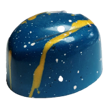52 minutes ago, sweettreateater said:I wonder what are the biggest contributors? Is it the reversible protein unfolding and denaturing? Or is it mainly just due to evaporating so much water out of the base, which is ultimately what would contributing to any iciness?
100% the latter. By evaporating water, you're increasing both the nonfat solids and the fat.
There is possibly some effect from denaturing the whey proteins, but I don't believe you're going to notice it in these recipes. Mainly because they are very heavy on egg custard, so they have more than adequate added emulsifiers already.
There is some research suggesting that with prolonged cooking, whey proteins can aggregate with casein proteins, forming a hydrocolloid with thickening / stabilizing ability. But this seems difficult to accomplish. Even Jeni Britton-Bauer of Jeni's Splendid—who's a pioneer in using milk proteins as emulsifiers in egg-free ice cream—adds starch as a stabilizer.
If you want to increase the fat and nonfat solids of an ice cream, evaporation is a way to do it. But you'll have an easier time and get more consistent results by just using a higher percentage of cream and dry milk.
In my experiments, cooking milk proteins to varying degrees in a formula that's lower in fat and much lower in egg yolk than Ruben's formulas, I find the effect to be extremely subtle. It's likely that you will only see any effect if you're using milk that's been pasteurized at low temperatures (and dry milk that's been spray-dried at low temperatures).
Edited to add:
There's something I'm leaving out. The differences aren't 100% evaporation; some of the difference is from adequately thickening the egg custard. Contrary to what used to be taught in cooking school, custard consistency is a factor of not just concentration and temperature, but also time. An egg custard brought to 162F for two minutes will thicken very little compared with one held at that temperature for 15 minutes. Dr. Cesar Vega confirmed this in tests done with a rheometer.




